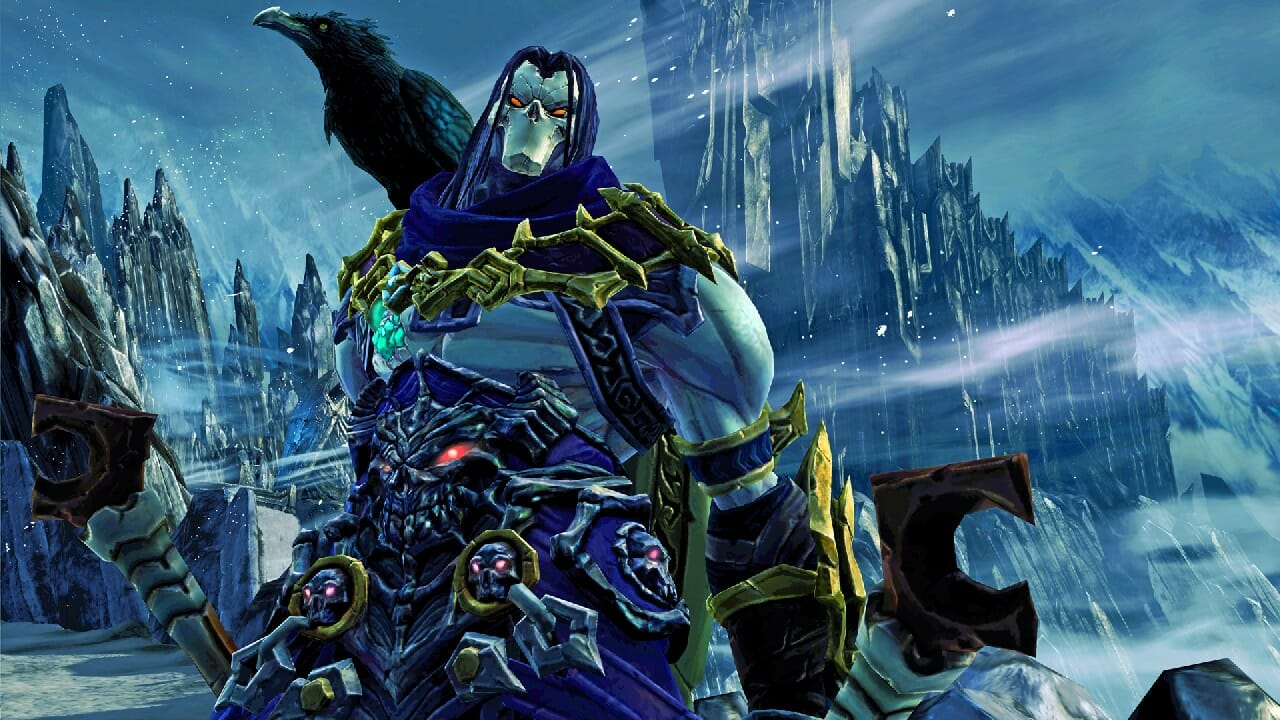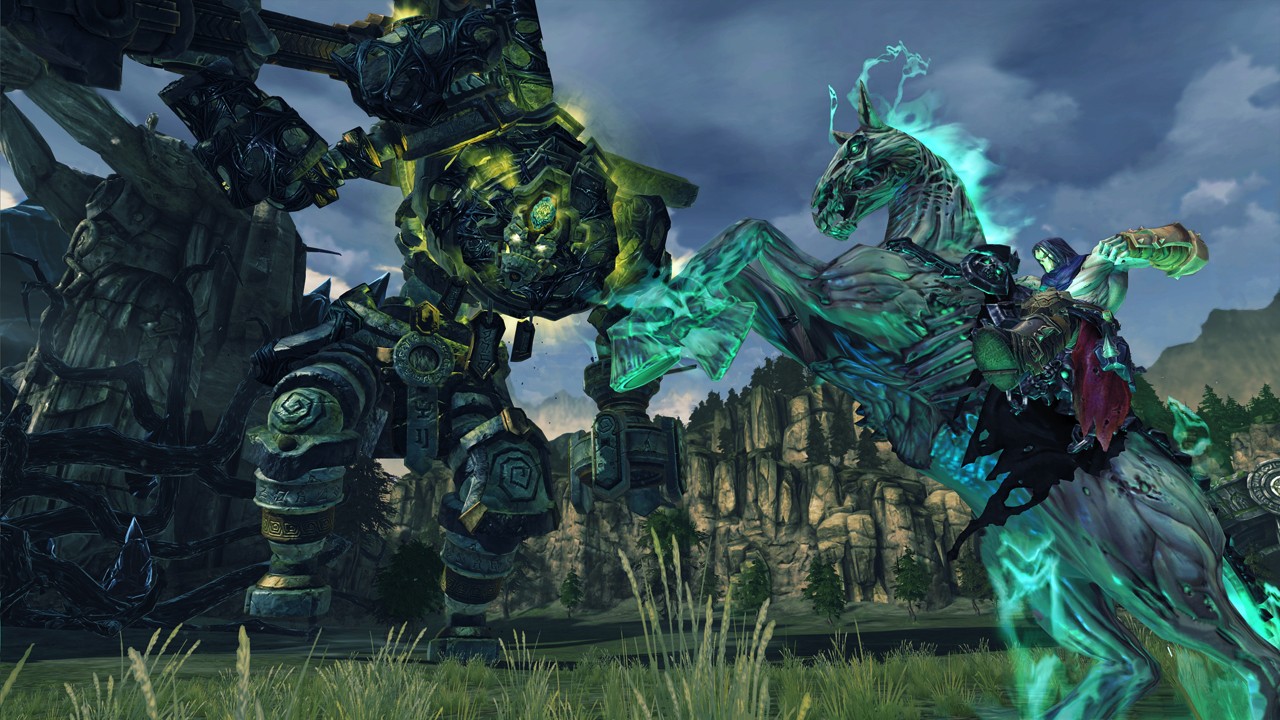
“When the Lamb opened the fourth seal, I heard the voice of the fourth living creature say, ‘Come!’ I looked, and there before me was a pale horse! Its rider was named Death, and he was given power over four worlds with dungeons and puzzles and loot and stuff, and Death was super snarky. Amen.”
-Revelations 6 or something
![]()
Video games are just now entering an era when its audience will know the medium’s full canon. We’ve played Zelda, and so Darksiders was not, as it were, a revelation. To best explain Darksiders, we would say, “It’s like Zelda,” right? The dungeon design, the skeleton keys, the mini-boss to gadget to boss to overworld trajectory – these are practically trademarked by the Zelda series, so any future appropriation will have to suffer under that shadow. At least, in that example, Darksiders plays with the ideas from a storied, beloved franchise.
Darksiders II, not to be outdone by its older brother, bastardizes the canon of The Legend of Zelda, God of War, Shadow of the Colossus, Diablo, Portal, Doom, The Elder Scrolls, Torchlight, Singularity, Prince of Persia, and, oh yes, the Bible.
Before this sounds too much like a single-minded judgment of Vigil Games’ potluck development style, know that the hodge-podge of mechanics and worlds and characters and ideas that is Darksiders II is a thrill ride at its best and only occasionally droll at its worst. The journey takes players through imaginative overworlds and dungeons packed with loot to grab, enemies to slay, walls to scale (a la Prince of Persia), and puzzling rooms to unlock. The real criticism to levy against the game’s amalgam approach is that because the developers diversified the creation of the experiences, the pillar moments in Darksiders II lack the foci that the games they embody have done so well. By consequence, the patchwork pieces aren’t as memorable, although they contain the rich mechanical elements that first made the concepts popular.
![]()
For example, Darksiders II’s protagonist, Death (the horseman of the apocalypse), one-ups his brother War from the first game by tackling ancient angelic and demonic forces fifty times larger than anything his brother encountered. Circling a corrupt stone guardian thirty stories tall on the back of Death’s pale horse, Despair, feels like a singularly lonely and wordless moment from Shadow of the Colossus. But the real moment of triumph, the coup de grace when Death vaults through the air and strikes the last soul stone to release the rock creature (yes, I know how ridiculous it sounds), plays out in a non-interactive cut scene.
And later, when Death arrives at the coliseum in hell riding a pirate ship pulled through space by two giant serpents, his epic dismount is also a cut scene. Rue the day that I first begged for a quick-time event, or something, anything to make me feel some sense of ownership over those moments of grandeur and bad-assery. No, instead I’m given the control of a dialogue tree when Death accepts another fetch quest from the King of Bones.
Inside that umbrage is further umbrage. The combat system (distinct from but reminiscent of God of War) is chock full of haptic feedback, and accents finishers with slow-mo and loads of gore, which paints a portrait of the fourth horseman of the apocalypse as I’d imagine. He’s ruthless, quick and brutal. Then he talks to an old guy and a goat-man and he’s out picking up key halves and ghosts to gently goad these NPCs into cooperation. I just saw him tear out a demon champion’s throat, and he can’t muster a little intimidation to coerce the pipe-smoking cattle-merchant? Darksiders II is its own intellectual property, so I wouldn’t charge Vigil with shaping its characters like, say, an outcast Greek god on a bloody vengeance trail, but some consistency in Death’s response to opposition is warranted.
The protagonist’s motivation is, then, also in question. I know that Death is “on a mission to restore his brother’s honor”, but I’m not made to believe that. The first level opens in medias res, a plot taking place chronologically alongside the events of the first game, and Death is thrust into an ice tower and pitted against War’s doppelganger. And that, apparently, is all the justification we get for Death to slash his scythes through four universes and wave upon wave of corrupted enemies of increasing strength, speed and volume.
To be clear, slashing those scythes is still as satisfying as it was in the first game, perhaps even more so with the inclusion of a skill tree and loot system. Instead of just buying abilities and sword maneuvers from Vulgrim (you can still do that), a leveling system moderates skill progress and forces players to choose, as an example, summoned ghoulies with fire or a spinning move with fire. Loot drops (a la Diablo, among others) embed RPG persistence into weapon and armor management. If the quality and type of items weren’t so procedurally generated, then the system might be downright addicting. As it is, the “legendary items” are well off the beaten path, usually only accessible through lengthy, rewarding side quests.

In defense of those unnecessary outings, the dungeons that have been built for missions outside of the main story arc aren’t randomized caves or hollows with the same goons and puzzles. Each dungeon was crafted specifically to fit the side quest, and generally has its own unique boss battle on top of head-scratching traversal challenges. Essentially, what makes up the Darksiders II players are funneled into is the same as the parts they can ignore, which shows some real confidence by Vigil and creates a more believable, fully-realized game world.
Players who want to step outside that world for some hacking and slashing can fast travel to The Crucible, a horde mode arena with waves of unlockable enemies. In Torchlight fashion, fast travel saves allow for popping in and out of dungeons to The Crucible and stores, lending a continuity to each of the four realms. Unlike Torchlight, Darksiders II doesn’t streamline the market process with a pet, although equipment comparison is visually apparent which makes for quick trades. Some lessons are learned, others are lost.
![]()
An unspoken rule in fantasy writing (maybe it’s been spoken by now) is to give the fiction reference points as handholds for the reader; make the characters relatable, weave an archetypical story, inject relatable human conflict, or just talk about something that’s been talked about before. All knowledge and especially learning is relative by nature, and literature that values that process is often better received for it.
The Darksiders fiction has an appreciation for this maxim, its biblical roots pulling errant pieces from John’s vision of the “End Times” as described in the book of Revelations. In pop culture exterior to the New Testament, the four horsemen, the lake of fire, and the New Jerusalem are, at least, known concepts, as are the hosts of demons and angels that take part in the Rapture.
Darksiders used up a lot of the big names like Uriel, Abaddon, heaven and God, so Darksiders II has to stick to more obscure references, going so far as to invent angelic worlds in its universe. The Tree of Life, a central figure in Darksiders II’s mythology, is actually mentioned in the book of Revelations as a healer of nations and product of the waters of the river of life. Even in the Christian world, who cares? I’ve got a personal investment in the idea of the apocalypse, in the concept of heaven, but I haven’t once given a thought to the tree next to the river in the world after the events of Revelations. The handholds here are thin and slippery, despite how well-designed the creatures of the damned and the halls of the light may be.
And so its fiction becomes a disappointing bastardization of some off-the-path biblical references in the same way that the game’s myriad mechanics don’t realize their inspirations. Not a single one of the portal puzzles is physics-based. None of the epic-scale battles give players real empowerment. Most of the puzzles, even, are just exercises in finding the right wooden ledge. If it weren’t for the exciting pace of combat, or the fullness of the game’s first two worlds (the other two dwindle in intricacy), this might as well be the first Darksiders with a time-travel gun near the end. It’s not a triumph, and it’s not a failure. It’s just a real bastard.
Darksiders II was developed by Vigil Games and published by THQ. Our review is based on the Xbox 360 version. It is also available for the PlayStation 3, PC and through OnLive.
Dan Crabtree is an I.T. guy and freelance writer with words on Paste, Ars Technica, Kill Screen, and Gamernode. His dog is considered handsome and well-read. You can find him (the human) on Twitter.